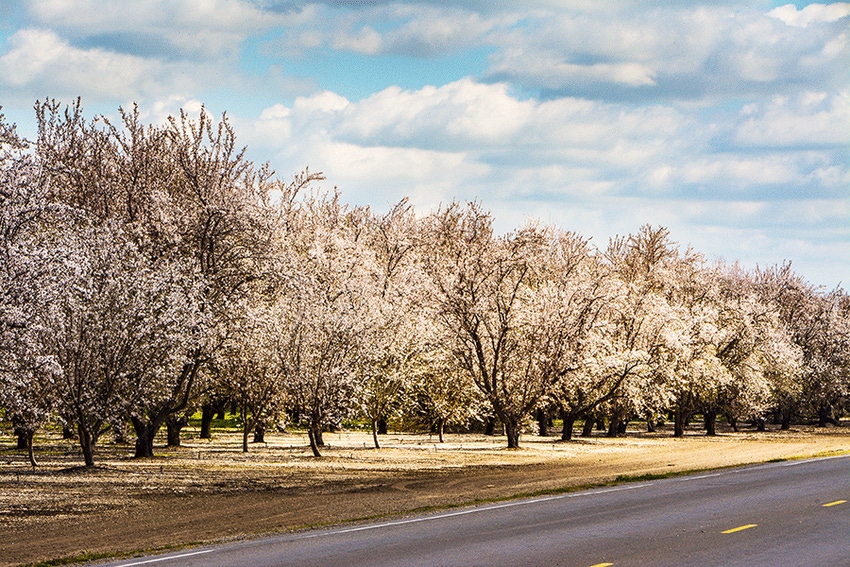
On your mark, get set — are you ready to grow in the upcoming nut season?
It has been suggested that successfully growing tree nuts can loosely be compared to thoroughbred horse racing: You can spend a fortune grooming a good steed for running the big races, toss in plenty of training and a lot of TLC, and one day you’re ready for that first big race.
Win or lose, like horse racing, tree nut farming starts with good conditioning (of soil and trees), months of tender loving care, and with good weather and perhaps a bit of good luck, soon the nut season ends with a checkered flag signaling the race is over, hopefully ending in a successful crop year.
The dormant season in the orchard is the time to ‘get on your mark’ by performing off-season tasks. After all, when March rolls around, it’s time to ‘get ready,’ as weather and other conditions improve and tasks turn to pheromone traps, mating disruption, and applications of K, among other things.
April signifies that the looming race is “off and running” and, if all things go as planned, well on its way to harvest in the early fall season.
LAST MINUTE TASKS
For the remainder of February, however, the winter season continues to rule, and the arrival of the month arguably marked the last full month of the dormant season, a time to complete last minute winter tasks. This may include final sanitation practices, addressing winter weeds, cleaning the orchard floor, and the application of nitrogen in the orchard, all in anticipation of first bud.
If you haven’t already done so, wrap up or amend your annual pest management plan, work on soil fertility issues and overall orchard health, and inspect and scout for such things as pest and disease issues. It’s also time to turn your attention to pollinator protection as you prepare for bud break and bloom, the official start time of the race to harvest.
If you are concerned about navel orangeworm — and you should be — this is the time for final and comprehensive orchard sanitation. UC-ANR orchard and IPM advisors emphasize that most NOW problems can be greatly curtailed with superior sanitation practices, which should be complete by mid-February or no later than the arrival of March in northern regions. It’s also a good time to start thinking about the irrigation season and steps you should take to prepare for full bloom.
WINTER WATER
According to University of California drought management guidelines for almonds, water stress affects more tree and crop development processes during the early season — from leaf out through shoot growth and development of terminal and lateral buds.
During this period, rapid vegetative growth is necessary for canopy development and fruiting positions. Concentrating on current moisture needs in the orchard seems to be top of the order of business for the month of February.
For several years, there has been an ongoing question and debate about winter irrigation and the benefits or stress involved when applying water to a dormant orchard. Depending on orchard location, this year has been shaping up to be a wet winter, and determining existing soil and tree moisture now should be your guide on when to begin your irrigation plan.
A check across California nut country tends to indicate adequate moisture is currently available to carry most orchards to bud break, but conditions vary according to location.
Irrigation and plant and soil moisture are so important, the topic is being covered in a dedicated article this month that deals with issues and actions like monitoring soil moisture, evapotranspiration issues, and moisture tests that can be accomplished using a stem pressure chamber and soil sensors. You can find that information online in the tree nut section of Western Farm Press or link to it from the Tree Nut Farm Press newsletter.
PESTS, DISEASES
Emily J. Symmes, IPM advisor for UCCE and the statewide IPM program, advises tree nut producers to spend time this month considering the scouting and control of common pests and diseases of nut trees in the orchard.
“Chances are good most scouting for San Jose scale, European fruit lecanium, and mite eggs has wrapped up by now. But continuing to monitor for signs of new pest activity remains a good practice as the new season gets underway,” she says.
Symmes warns that with bloom sprays for almond diseases right around the corner, it is time to begin thinking about how to approach pest management activities when bees are present in the orchard. She reminds growers to be certain to strictly adhere to the Honey Bee Management Practices, as noted on the Almond Board website, and says the only insect pest that can be effectively treated during this time is peach twig borer, and there are other alternate treatment timings that are just as effective for this pest.
Symmes and a group of other farm advisors have prepared a narrative to remind producers of other issues to address in the month of February, and as as bloom begins to unfold in coming weeks. Those recommendations were published in the recent Sacramento Valley Almond Newsletter winter edition, and include consideration of honey bee health and safety for any disease control measures taken during bloom.
Advisors recommend spraying only fungicides during bloom and leaving insecticides, nutrients, and adjuvants out of the tank. They also caution of the need to provide clean water for bees and to set hives in a spot where the morning sun will warm them and encourage early morning activity.
Also, of note, Symmes reminds growers to hang San Jose Scale pheromone traps during the last week of February and to remove or mow weeds and cover crops before bloom to aid in frost protection. With spring just around the corner, there is urgency to accomplish orchard tasks as weather and conditions permit, starting with final sanitation.
Here’s hoping for a good crop year.
About the Author(s)
You May Also Like






